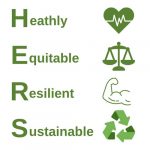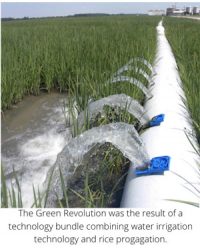In 2020, Cornell University released research conducted by an expert panel on the topic of “innovations to build sustainable, equitable, inclusive food value chains.” Panelist Christopher Barrett, an agricultural economist, created a presentation using this report titled “ Bundling Innovations for Agri-Food Systems Transformation: Reflections for Canadian Leaders” for the Canadian Agri-Food Policy Institute. Below is a summary of essential actions outlined by Barret in order for Canada to successfully implement a regenerative food chain. To view the full report, please click here.
 Overall Vision
Overall Vision
Canada must focus on building a food system using the HERS acronym: healthy, equitable, resilient, and sustainable. Using the Sustainable Development Goals created by the UN, Canada must act to implement and scale these goals in order to create a sustainable food system for future Canadians. The external drivers for this shift are negative climate changes, increasing urbanization, and income growth.
Three Essential Actions
 1. Use technology bundles: Bundle technology across science- order to solve multi-faceted problems. Bundling realizes the synergies needed to adapt and scale to meet the demands of the community.(ex: the Green Revolution, which saw a shift from small-scale farms to industrial-sized agribusinesses, came about through the synergy of rice propagation and new water irrigation technology). New innovations will allow producers to meet heterogeneous needs, such as the need for a diverse diet that comes from a variety of sources to combat vitamin/mineral deficiencies (ex: fortification of basic crops like flour and rice with added vitamins).
1. Use technology bundles: Bundle technology across science- order to solve multi-faceted problems. Bundling realizes the synergies needed to adapt and scale to meet the demands of the community.(ex: the Green Revolution, which saw a shift from small-scale farms to industrial-sized agribusinesses, came about through the synergy of rice propagation and new water irrigation technology). New innovations will allow producers to meet heterogeneous needs, such as the need for a diverse diet that comes from a variety of sources to combat vitamin/mineral deficiencies (ex: fortification of basic crops like flour and rice with added vitamins).
2. Decouple food production from land to reduce environmental footprint: Decoupling food production from land is increasingly necessary, as well as culturally, economically, and technologically feasible. We have already decoupled food production and manual labor through mechanization. One way to do this is through vertical agriculture, which creates a high yield with a small footprint. Vertical agriculture is typically done using greenhouse-like structures that allow produce to be stacked on top of each other. With changes in farming practices, it is crucial to facilitate a transition for livestock producers and traditional growers who will be threatened by this technology using alternate revenue streams. An example of this could be transitioning farmed land into spaces where energy can be farmed (Canada is well equipped for solar and wind farming).
3. Reconfigure Agri-food support systems: The government needs to invest in Agri-Food Canada funded research on essential public goods and services. Much of current government agri-food system spending is wasteful ($2 billion daily spent on subsidies globally) and should be redirected towards social protection programs, agri-food research, and physical/institutional infrastructure. Furthermore, the government currently subsidizes processes with negative externalities, when we should be subsidizing processes with positive externalities. For example, Canada implicitly subsidizes the harvesting of carbon and topsoil through crop insurance, while we should be encouraging marginal land management through subsidies.
Sources
https://www.youtube.com/watch?v=GjfgDDet7-g
https://blogs.cornell.edu/nature-sustainability/
https://bluearthrenewables.com/projects/suffield-solar-project/

